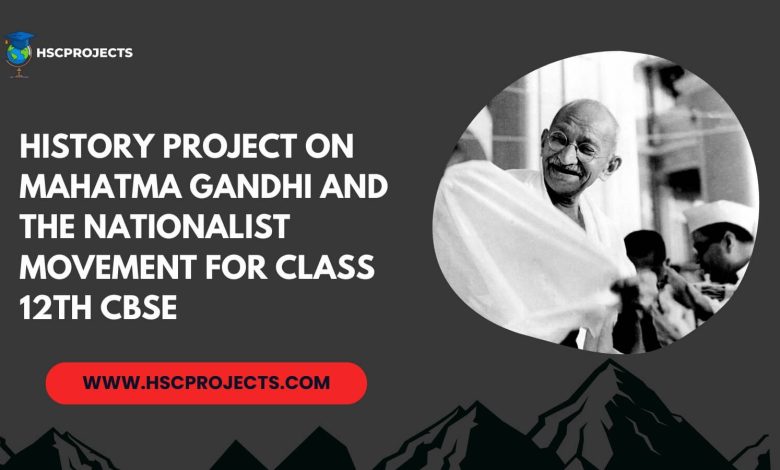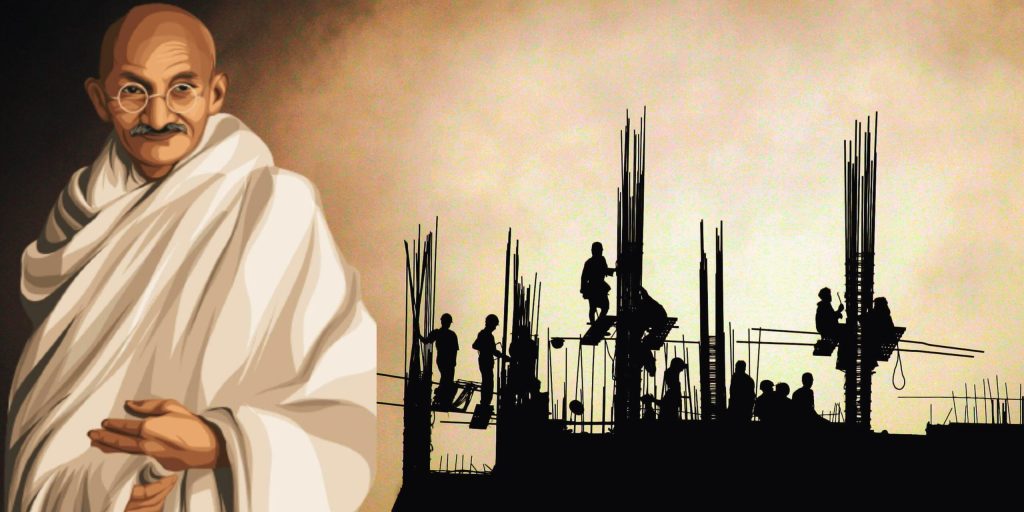
History Project On Mahatma Gandhi And The Nationalist Movement For Class 12th CBSE
Acknowledgment
would like to express my sincere gratitude to everyone who contributed to the successful completion of this History project on “Mahatma Gandhi and the Nationalist Movement.” This project has been a journey of exploration and learning, and I am thankful for the support and guidance received throughout.
First and foremost, I extend my heartfelt thanks to my History teacher, [Teacher’s Name], for providing valuable insights, continuous encouragement, and constructive feedback. Your expertise has been instrumental in shaping the direction of this project.
I am also grateful to my classmates who engaged in insightful discussions, shared resources, and provided moral support. The collaborative effort has enriched the quality of this project.
A special thank you to the staff of the school library for facilitating access to a wide range of resources and reference materials. The availability of these materials significantly enhanced the depth and authenticity of the content.
Last but not least, I would like to express my deepest appreciation to my family for their unwavering support, understanding, and encouragement. Their encouragement kept me motivated during challenging times, and I am truly grateful for their support.
Introduction
As the 20th century dawned, India found itself ensnared in the grip of British colonial rule, a period marked by oppression, economic exploitation, and a fervent desire for self-determination. It was in this historical context that Mahatma Gandhi, born Mohandas Karamchand Gandhi in 1869, rose as a towering figure, leading a transformative movement that would reshape the course of Indian history.
Gandhi wasn’t just a political leader; he embodied a philosophy that echoed the aspirations of millions. His role in the Indian Nationalist Movement was pivotal, steering the course toward freedom from British imperialism. In an era marred by British policies that fueled discontent, Gandhi, with his blend of spirituality, non-violence, and civil disobedience, emerged as a beacon of hope, aiming to awaken the moral conscience of a nation.
The socio-economic landscape of the late 19th and early 20th centuries was scarred by poverty, discrimination, and a profound yearning for autonomy. Against this backdrop, Gandhi’s entry into the political stage was revolutionary, offering a unique approach that went beyond conventional strategies. His goal was not just political change but a moral revolution, grounded in the principles of truth and justice.
In the following paragraphs, we’ll explore not only Mahatma Gandhi’s life and contributions but also the intricate web of events and ideologies that defined the Indian Nationalist Movement, unraveling the layers of a movement that went beyond political boundaries.

Importance
Mahatma Gandhi’s imprint on Indian history is indomitable, extending beyond his role as a leader in the Nationalist Movement. His significance lies not only in guiding India toward independence but also in the profound impact of his philosophy on the nation’s collective consciousness.
Gandhi’s importance emanates from his unique approach to achieving political objectives, centered around the concept of non-violence or “Ahimsa.” In a world accustomed to the brutality of political struggles, Gandhi’s commitment to non-violence was revolutionary, providing a distinctive path for the Indian independence movement.
Ahimsa, for Gandhi, was not just a tactic but a way of life, a transformative ideology seeking to change individuals and societies. This commitment became a powerful tool, positioning the Indian Nationalist Movement as a moral force, gaining both national and international support.
At the core of Gandhi’s philosophy was civil disobedience, a form of nonviolent protest that deliberately violated unjust laws. This approach aimed to expose the moral bankruptcy of oppressive policies rather than overthrow the British government through force. Through movements like the Salt March and the Non-Cooperation Movement, Gandhi catalyzed a new wave of resistance challenging the foundations of British colonial rule.
Gandhi’s ideas resonated not only with the intellectual elite but also with the common man. His ability to mobilize millions stemmed from an astute understanding of the nation’s pulse. By weaving a narrative of self-reliance, dignity, and unity, Gandhi ignited a spark that spread across all walks of life, engulfing people in the fervor of the nationalist cause.
In the upcoming sections, we’ll delve into the practical manifestations of Gandhi’s philosophy, exploring key events and movements that bear the indelible imprint of his ideas. Through this exploration, we aim to illuminate the profound importance of Mahatma Gandhi in shaping the destiny of a nation yearning for freedom.
Objectives of the Nationalist Movement
Let’s now delve into the main goals of the Indian Nationalist Movement:
- Uncover overarching aspirations: The movement was fueled by a desire for autonomy, driven by socio-political and economic objectives that united nationalists in their quest for freedom.
- Demand for self-rule: Indians yearned to break free from the shackles of British colonialism, with the demand for self-rule evolving from decades of discontent.
- Explore key events and movements: We’ll examine strategic movements like the Non-Cooperation Movement and the Salt March, understanding their impact on the national psyche and their pivotal role in the journey toward independence.
- In dissecting these objectives, we aim to uncover the driving forces behind the Nationalist Movement and the strategic maneuvers that defined its trajectory.

Key Events and Movements
Let’s provide a chronological overview of significant events and movements led by Gandhi:
- Gandhi’s leadership timeline: Starting from the early phases of the Indian Nationalist Movement, we’ll explore the progression of events, from Champaran and Kheda Satyagrahas to more widespread movements.
- Non-Cooperation Movement: Launched in 1920, we’ll examine how it marked a turning point in the struggle for independence, its impact on the masses, and its role in shaping non-violent resistance.
- Civil Disobedience Movement: Initiating in 1930 with the Salt March, we’ll evaluate the motivations behind this movement, its widespread participation, and its influence on public sentiment.
- Quit India Movement: We’ll analyze the circumstances leading to the 1942 Quit India Movement, exploring its intensity, scale, and consequences on both the Indian political landscape and World War II.
- By providing a chronological overview and delving into the impact of these pivotal events and movements, we aim to unravel the dynamic tapestry of the Indian Nationalist Movement under the leadership of Mahatma Gandhi.
Gandhi’s Leadership Style
Now, let’s explore Mahatma Gandhi’s distinctive leadership style:
- Core principles: Investigate the principles defining Gandhi’s approach, emphasizing his commitment to truth (Satyagraha), non-violence (Ahimsa), and self-reliance.
- Truth and decision-making: Delve into how Gandhi’s unwavering adherence to truth influenced his decisions, fostering trust and integrity.
- Non-violence as resistance: Explore the impact of non-violence as both a moral and strategic dimension of resistance.
- Advocacy for self-reliance: Discuss Gandhi’s emphasis on self-reliance at individual and national levels as tools for empowerment and resilience.
- Mobilizing diverse groups: Analyze Gandhi’s ability to connect with people from various backgrounds, breaking down barriers of caste, class, and religion.
- Inclusive leadership: Examine instances where Gandhi’s leadership successfully bridged societal divides, fostering unity and common purpose.
- Through this exploration, we aim to gain insights into the transformative nature of Gandhi’s leadership within the context of the Indian Nationalist Movement.
Role of Women in the Nationalist Movement
Now, let’s highlight the significant contribution of women in the Indian Nationalist Movement:
- Pivotal role: Illuminate the often overlooked but pivotal role played by women in various capacities, from grassroots activism to leadership roles.
- Women leaders: Spotlight contributions of leaders like Sarojini Naidu and Kamala Nehru, exploring their roles in movements such as Suffragette and Home Rule.
- Grassroots activism: Discuss the widespread participation of women at the grassroots level, showcasing their commitment to the nationalist cause.
- Impact on societal perceptions: Explore how women’s involvement challenged gender norms and societal expectations, transforming perceptions of their roles.
- Women’s organizations: Highlight the formation and activities of women’s organizations, such as the All India Women’s Conference, as platforms for voicing concerns and contributing to the nationalist agenda.
Conclusion
In conclusion, the impact of Mahatma Gandhi and the Nationalist Movement on India’s quest for independence is indelible and profound. Gandhi’s visionary leadership, marked by principles of truth, non-violence, and self-reliance, served as the moral compass that guided millions in their pursuit of freedom. The Nationalist Movement, under his guidance, became a powerful force that transcended political boundaries, uniting a diverse nation under the common goal of liberation from British colonial rule. The strategic brilliance behind key movements like the Non-Cooperation Movement, Civil Disobedience Movement, and Quit India Movement showcased not only the strength of non-violent resistance but also the ability to mobilize masses on an unprecedented scale.
As India emerged from the shadows of colonialism, the legacy of Mahatma Gandhi continued to shape the nation’s identity. His principles became foundational pillars in the construction of a democratic and inclusive society. The echoes of his philosophy reverberated in the drafting of the Indian Constitution, emphasizing values of justice, equality, and fraternity. Post-independence India, guided by the enduring spirit of Gandhi, navigated the challenges of nation-building with resilience and determination. The principles of non-violence and peaceful coexistence remain integral to India’s diplomatic approach on the global stage, solidifying Gandhi’s lasting influence on the nation’s ethos. In reflecting on the journey from colonial subjugation to a vibrant, sovereign democracy, it becomes evident that Mahatma Gandhi’s principles not only paved the way for India’s independence but also continue to illuminate its path towards progress and unity.
Bibliography
- Brown, Judith M. (1991). Gandhi: Prisoner of Hope. Yale University Press.
- Guha, Ramachandra. (2007). Gandhi Before India. Vintage.
- Wolpert, Stanley. (2001). Gandhi’s Passion: The Life and Legacy of Mahatma Gandhi. Oxford University Press.
- Gopal, Sarvepalli. (2006). Jawaharlal Nehru: A Biography. Oxford University Press.
- Fischer, Louis. (1982). The Life of Mahatma Gandhi. HarperCollins.
- Gandhi, Mahatma. (1957). Autobiography: The Story of My Experiments with Truth. Beacon Press.
- Wolpert, Stanley. (2001). A New History of India. Oxford University Press.
- Tendulkar, D. G. (1951). Mahatma: Life of Mohandas Karamchand Gandhi. Publications Division, Government of India.
- Bose, Sugata. (2015). His Majesty’s Opponent: Subhas Chandra Bose and India’s Struggle against Empire. Harvard University Press.
- Khan, Yasmin. (2007). The Great Partition: The Making of India and Pakistan. Yale University Press.
Certificate of Completion
[Student’s Name][Class/Grade Level]This is to certify that I, [Student’s Name], a [Class/Grade Level] student, have successfully completed the “History Project on Mahatma Gandhi And The Nationalist Movement For Class 12th CBSE.” The project explores the fundamental principles and key aspects of the chosen topic, providing a comprehensive understanding of its significance and implications.
In this project, I delved into in-depth research and analysis, investigating various facets and relevant theories related to the chosen topic. I demonstrated dedication, diligence, and a high level of sincerity throughout the project’s completion.
Key Achievements:
Thoroughly researched and analyzed project on “History Project on Mahatma Gandhi And The Nationalist Movement For Class12th CBSE.”
Examined the historical background and evolution of the subject matter.
Explored the contributions of notable figures in the field.
Investigated the key theories and principles associated with the topic.
Discussed practical applications and real-world implications.
Considered critical viewpoints and alternative theories, fostering a well-rounded understanding.
This project has significantly enhanced my knowledge and critical thinking skills in the chosen field of study. It reflects my commitment to academic excellence and the pursuit of knowledge.
Date: [Date of Completion]Signature: [Your Signature] [School/Institution Name][Teacher’s/Examiner’s Name and Signature]
In order to download the PDF, You must follow on Youtube. Once done, Click on Submit
Follow On YoutubeSubscribed? Click on Confirm
Download History Project On Mahatma Gandhi And The Nationalist Movement For Class 12th CBSE PDF






